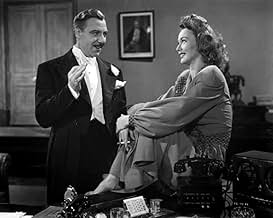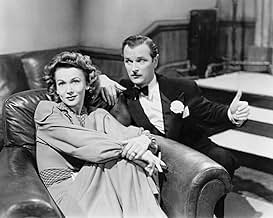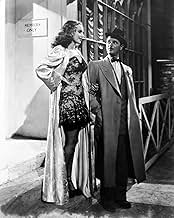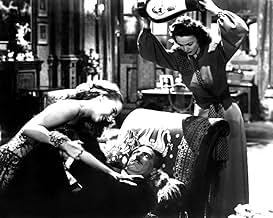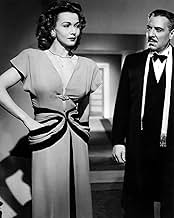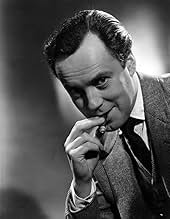Agrega una trama en tu idiomaIn post- WW2 Britain, an American fashion journalist, her ex-army fiancé, and a gang of honest toughs from a local gym attempt to bring black market organized crime to justice.In post- WW2 Britain, an American fashion journalist, her ex-army fiancé, and a gang of honest toughs from a local gym attempt to bring black market organized crime to justice.In post- WW2 Britain, an American fashion journalist, her ex-army fiancé, and a gang of honest toughs from a local gym attempt to bring black market organized crime to justice.
Carol van Derman
- Mercia Lane
- (as Carol Van Derman)
Opiniones destacadas
Being vaguely aware of this obscure British noir, I had acquired it a few years ago from a film buff friend of mine (who also happens to be an award-winning lyricist) following a biography shown on local TV of Maltese film actor Joseph Calleia. It had not occurred to me to include the film in my ongoing Thriller marathon; however, I could not very well leave it out once I read, just a couple of days ago, an article about "Time Out"'s recent "100 Best British Films" in which contributor/French film director Bertrand Tavernier bemoaned there not being enough room in his Top 10 list for, among others, NOOSE! I was under the mistaken impression that the copy I got was of inferior quality which would not best be suited for display on my 40" monitor which is why I watched it on a much smaller screen but, as it turned out, the film did get released on DVD in the UK.
Adapted from his own stage play by Welsh writer Richard Llewellyn (best-known for having penned John Ford's 1941 Oscar-laden HOW GREEN WAS MY VALLEY), the film largely escapes its theatrical roots thanks to Greville's admirably Expressionistic direction that should have earned it a much better reputation (even among fans of the genre and film buffs in general) virtually comparable to that nowadays enjoyed by Alberto Cavalcanti's THEY MADE ME A FUGITIVE (1947) and Jules Dassin's similarly Soho-set NIGHT AND THE CITY (1950; with a wrestling back-drop to NOOSE's prizefighting milieu)! Actually, I do think there is a reason for this neglect since, rather than the relentless post-war bleakness and realism associated with this type of film, there is a welcome air of theatricality (in the acting) and light-heartedness (in the comic incidents that crop up intermittently).
Carole Landis, who for some reason is forever losing her shoes, is a bit too jovial for a noir heroine; ironically, she would die a suicide later in the year, after completing BRASS MONKEY (1948), another genre effort which I hope to acquire (and include) in my current schedule. Derek Farr, too, is a bland leading man – though, as already mentioned, he manages to organize a boxing outfit into efficient opposition to the gangsters involved. On the other hand, Joseph Calleia has one of his better roles: atypically, he received before-the-title billing for this rare foray to the U.K. (incidentally, at the time, our native country was a British colony) and is constantly breaking into Italian and singing operatic arias; though something of a caricature (especially in those scenes featuring his luscious starlet protégée Carol Van Derman), his is an impressive performance regardless. Despite figuring way down in the cast list, Nigel Patrick is really the protagonist as Calleia's right-hand man: he brings such manic energy to the role that it would not be amiss in a screwball comedy!; in fact, on the strength of this, I managed to get hold of Patrick's intriguing self-directed religious parable JOHNNY NOBODY (1961). Stanley Holloway, then, tackles an unusually serious role as the cop on Calleia's trail, while Hay Petrie gives a memorably chilling portrayal as Calleia's combination of private barber and assassin (actually looking a bit like Claude Rains!).
One last thing: I watched this very late at night, believing it to be just 76 minutes long as given on the IMDb: presumably, this duration alludes to the U.S. release print that was re-titled THE SILK NOOSE – being a reference to Petrie's murder 'weapon'; however, the copy I acquired turned out to be the full-length British version running 98 minutes.
Adapted from his own stage play by Welsh writer Richard Llewellyn (best-known for having penned John Ford's 1941 Oscar-laden HOW GREEN WAS MY VALLEY), the film largely escapes its theatrical roots thanks to Greville's admirably Expressionistic direction that should have earned it a much better reputation (even among fans of the genre and film buffs in general) virtually comparable to that nowadays enjoyed by Alberto Cavalcanti's THEY MADE ME A FUGITIVE (1947) and Jules Dassin's similarly Soho-set NIGHT AND THE CITY (1950; with a wrestling back-drop to NOOSE's prizefighting milieu)! Actually, I do think there is a reason for this neglect since, rather than the relentless post-war bleakness and realism associated with this type of film, there is a welcome air of theatricality (in the acting) and light-heartedness (in the comic incidents that crop up intermittently).
Carole Landis, who for some reason is forever losing her shoes, is a bit too jovial for a noir heroine; ironically, she would die a suicide later in the year, after completing BRASS MONKEY (1948), another genre effort which I hope to acquire (and include) in my current schedule. Derek Farr, too, is a bland leading man – though, as already mentioned, he manages to organize a boxing outfit into efficient opposition to the gangsters involved. On the other hand, Joseph Calleia has one of his better roles: atypically, he received before-the-title billing for this rare foray to the U.K. (incidentally, at the time, our native country was a British colony) and is constantly breaking into Italian and singing operatic arias; though something of a caricature (especially in those scenes featuring his luscious starlet protégée Carol Van Derman), his is an impressive performance regardless. Despite figuring way down in the cast list, Nigel Patrick is really the protagonist as Calleia's right-hand man: he brings such manic energy to the role that it would not be amiss in a screwball comedy!; in fact, on the strength of this, I managed to get hold of Patrick's intriguing self-directed religious parable JOHNNY NOBODY (1961). Stanley Holloway, then, tackles an unusually serious role as the cop on Calleia's trail, while Hay Petrie gives a memorably chilling portrayal as Calleia's combination of private barber and assassin (actually looking a bit like Claude Rains!).
One last thing: I watched this very late at night, believing it to be just 76 minutes long as given on the IMDb: presumably, this duration alludes to the U.S. release print that was re-titled THE SILK NOOSE – being a reference to Petrie's murder 'weapon'; however, the copy I acquired turned out to be the full-length British version running 98 minutes.
Edmond Greville brought a gallic sensibility to this vivid evocation of the postwar days when Soho was a byword for criminality and vice, fluidly photographed by Hone Glendinning and ending in a slam-bang finale.
Obligatory American imports Joseph Calleia and Carole Landis both give excellent accounts of themselves as "the nastiest thug in Europe" and his nemesis "the best fashion editor in the business". A uniformly memorable supporting cast include Nigel Patrick in full-on spiv mode, John Salew as Patrick's perspiring courier rejoicing in the name 'Greasy', and Hay Petrie in his creepiest role since he played Quilp as a murderous henchman known only as 'The Barber'.
Obligatory American imports Joseph Calleia and Carole Landis both give excellent accounts of themselves as "the nastiest thug in Europe" and his nemesis "the best fashion editor in the business". A uniformly memorable supporting cast include Nigel Patrick in full-on spiv mode, John Salew as Patrick's perspiring courier rejoicing in the name 'Greasy', and Hay Petrie in his creepiest role since he played Quilp as a murderous henchman known only as 'The Barber'.
I rated this film with 6/10 mainly because the final punch-up by the boxers with the mobster gang was inconsistent, being almost comic slapstick with what had gone before involving which involved killings.As is commonly known Carole Landis had been a girlfriend of Rex Harrison and possibly through blighted affection committed suicide the same year as this film aged 29.Nigel Patrick plays an immoral cockney spiv not so ruthless as his partner an Italian gangster played by Joseph Calleia who is prone to lapse into "Don Giovanni" by Mozart occasionally.Stanley Holloway as the detective plays his part without any of the humour found in many other of his film portrayals.Derek Farr gives an unremarkable workman-like performance as the fiancé of Carole Landis.
I was surprised to find this full length 1948 film on Youtube probably because it is in the public domain and therefore out of copyright.
I was surprised to find this full length 1948 film on Youtube probably because it is in the public domain and therefore out of copyright.
NOOSE is a well-plotted but oddly uninspiring little crime film which deals with efforts to bring down an Italian black market racketeer operating in London following WW2. His sheer breadth of power means that the authorities are powerless against him, until a lone female reporter decides to write a scoop that brings him out of the woodwork and up against her.
There's some great material in the narrative here, including a completely amoral villain who enjoys using knuckle dusters to beat up women! The stark gang violence makes ahead of its time, but it's a pity that the execution is less than stellar. The film plods when it should grip, and it only really gets going in the last twenty minutes or so, with an unusual and rather powerful climax. It's one of those rare films where the women are both empowered and sexualised, leaving the men looking weak by comparison.
The tragic Carole Landis stars in her penultimate acting role before her untimely suicide and very good she is too: bright, brassy, and running rings around the menfolk. Joseph Calleia and Derek Farr are rather uninspired as the rival protagonists, though we do get the likes of Stanley Holloway in support, and even a brief cameo for Michael Ripper. Nigel Patrick is something of a scene stealer as a loud-mouth spiv, and although his telephone manner is absolutely hilarious, I found his brash character ended up being too over the top for his own good.
There's some great material in the narrative here, including a completely amoral villain who enjoys using knuckle dusters to beat up women! The stark gang violence makes ahead of its time, but it's a pity that the execution is less than stellar. The film plods when it should grip, and it only really gets going in the last twenty minutes or so, with an unusual and rather powerful climax. It's one of those rare films where the women are both empowered and sexualised, leaving the men looking weak by comparison.
The tragic Carole Landis stars in her penultimate acting role before her untimely suicide and very good she is too: bright, brassy, and running rings around the menfolk. Joseph Calleia and Derek Farr are rather uninspired as the rival protagonists, though we do get the likes of Stanley Holloway in support, and even a brief cameo for Michael Ripper. Nigel Patrick is something of a scene stealer as a loud-mouth spiv, and although his telephone manner is absolutely hilarious, I found his brash character ended up being too over the top for his own good.
Joseph Calleia and Nigel Patrick have built up a massive and occasionally underworld organization. When one of their murders comes to the attention of reporter Carole Landis, she begins a series of newspaper articles. Their increasingly threatening reaction does not faze her, but it leads her boyfriend, Derek Farr, into organizing an armed rebellion. In the meantime, slogging police inspector Stanley Holloway is closing in from his own end.
The script is by Richard Llewellyn, based on his stage play. It's been properly opened up for the screen. The problem is that it's shifting tone, from comedy to drama, never quite works. Joseph Calleia, fine actor that he is, is saddled with a heavy accent and tries to be simultaneously funny and terrifying. Patrick's character spends a lot of time as a fast-talking Cockney, more interested in performing his comedy bits on the telephone, until he decides to suddenly take matters into his own hands and take charge.
The result is a movie that is never quite sure what it wants to be, and tries to distract the audience from that uncertainty.
The script is by Richard Llewellyn, based on his stage play. It's been properly opened up for the screen. The problem is that it's shifting tone, from comedy to drama, never quite works. Joseph Calleia, fine actor that he is, is saddled with a heavy accent and tries to be simultaneously funny and terrifying. Patrick's character spends a lot of time as a fast-talking Cockney, more interested in performing his comedy bits on the telephone, until he decides to suddenly take matters into his own hands and take charge.
The result is a movie that is never quite sure what it wants to be, and tries to distract the audience from that uncertainty.
¿Sabías que…?
- Trivia"Noose" was filmed in England during January and February of 1948. This was the final movie Carole Landis made before her death.
- ConexionesFeatured in Viaje por el cine francés (2016)
- Bandas sonorasWhen Love Has Passed You By
Composed by Edward Dryhurst
Lyrics by Barry Gray and Jean Cavall
Performed by Olive Lucius (uncredited)
Selecciones populares
Inicia sesión para calificar y agrega a la lista de videos para obtener recomendaciones personalizadas
Detalles
- Fecha de lanzamiento
- País de origen
- Idiomas
- También se conoce como
- The Silk Noose
- Locaciones de filmación
- Warner Brothers First National Studios, Teddington Studios, Teddington, Middlesex, Inglaterra, Reino Unido(studio: made at Warner Bros. First National Studios, Teddington, England.)
- Productoras
- Ver más créditos de la compañía en IMDbPro
- Tiempo de ejecución1 hora 16 minutos
- Color
- Relación de aspecto
- 1.37 : 1
Contribuir a esta página
Sugiere una edición o agrega el contenido que falta

Principales brechas de datos
By what name was Noose (1948) officially released in Canada in English?
Responda
